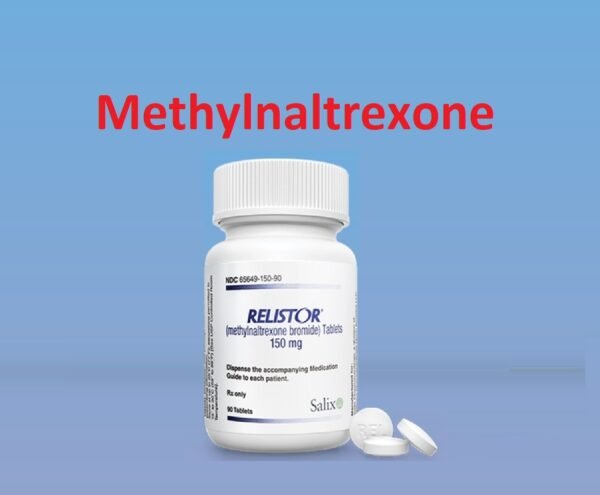Methylnaltrexone (brand name: Relistor) is a medication that is used to treat opioid-induced constipation (OIC). Opioids, commonly used for pain relief, can cause constipation by slowing the movement of stool through the intestines. Methylnaltrexone works by targeting the mu-opioid receptors in the intestines without affecting the receptors in the brain. By doing this, it can help restore normal bowel function in patients without interfering with the pain-relieving effects of the opioid medication.
Methylnaltrexone (Relistor), an opioid-receptor antagonist with peripheral action, is used to treat persistent constipation (in cancer patients and those with a terminal illness).
Methylnaltrexone (Relistor) Uses:
- Advanced sickness and opioid-induced constipation (injection only):
- Used to treat opioid-induced constipation in individuals who need opioid dose escalation for palliative care due to advanced illness or pain from aggressive cancer.
- Constipation brought on by opiate use (from pills and injections) and ongoing non-cancer pain:
- Used to treat patients with chronic non-cancer pain, including those who continue to have pain after receiving therapy for cancer in the past and do not require frequent (weekly, for example) opioid dosage escalation.
Read: Naltrexone (Revia, Vivitrol); Uses, Dose, Side effects Read: Naloxone (Narcan); Uses, Dose, Side effects, Indication
Methylnaltrexone (Relistor) Dose in Adults:
Methylnaltrexone (Relistor) Dose in the treatment of Opioid-induced constipation with advanced illness:
How to Take: Give one shot under the skin every two days if needed. Don't give more than one shot in a day.
Dosage based on weight:
- If less than 38 kg: Take 0.15 mg for every kg you weigh. Round up the dose.
- If 38 kg to less than 62 kg: Take 8 mg.
- If 62 kg to 114 kg: Take 12 mg.
- If more than 114 kg: Take 0.15 mg for every kg you weigh. Round up the dose.
Methylnaltrexone (Relistor) Dose for Chronic Non-Cancer Pain with Opioid-Induced Constipation:
Before Starting:
- Stop all regular laxatives.
- If after 3 days you don't see any improvement, you can start taking laxatives again.
How to Take:
- Pill form: Take one 450 mg pill once a day.
- Injection: Give one 12 mg shot under the skin once a day.
Use in Children:
Not indicated.
Methylnaltrexone (Relistor) Pregnancy Risk Category: B1
- Studies on animals didn't show any harmful effects on their babies.
- But, if a pregnant woman takes methylnaltrexone, her newborn might show signs of withdrawal from opioids.
Methylnaltrexone use during breastfeeding:
- We don't know if methylnaltrexone gets into breast milk.
- But because there's a chance it could harm a breastfeeding baby, the company that makes the medicine recommends not breastfeeding while taking it.
Methylnaltrexone (Relistor) Dose in Kidney Disease:
For Methylnaltrexone Dosage Based on Kidney Function (measured by Creatinine Clearance or CrCl):
- If your kidneys work really well (CrCl is 60 mL/minute or more):
- You don’t need to change the regular dosage.
- If your kidneys don't work as well (CrCl is less than 60 mL/minute):
For very sick patients with constipation due to pain medicine:
- Injection:
- If less than 38 kg: Take 0.075 mg for every kg you weigh every two days. Round up the dose.
- If 38 kg to less than 62 kg: Take 4 mg every two days.
- If 62 kg to 114 kg: Take 6 mg every two days.
- If more than 114 kg: Take 0.075 mg for every kg you weigh every two days. Round up the dose.
For people with long-term pain not from cancer:
-
- Pill: Take a 150 mg pill once a day.
- Injection: Give a 6 mg shot under the skin once a day.
- If you have serious kidney issues and are on dialysis:
- The manufacturer doesn't provide specific dosage guidelines because they haven't studied it.
Methylnaltrexone (Relistor) Dose in Liver disease:
For Methylnaltrexone Dosage Based on Liver Function (measured by Child-Pugh classification):
- For very sick patients with constipation due to pain medicine:
- The manufacturer doesn't give specific dosages based on liver health.
- If using the injection, and the patient has severe liver issues (Child-Pugh class C), follow the same guidelines as for people with long-term pain not from cancer.
- For people with long-term pain not from cancer:
Pill Form:
-
- Mild liver issues (Child-Pugh class A): No change in regular dosage.
- Moderate to severe liver issues (Child-Pugh class B and C): Take one 150 mg pill daily.
Injection:
-
- Mild to moderate liver issues (Child-Pugh class A or B): No change in regular dosage.
- Severe liver issues (Child-Pugh class C):
- If less than 38 kg: Take 0.075 mg for every kg you weigh daily. Round up the dose.
- If 38 kg to less than 62 kg: Take 4 mg daily.
- If 62 kg to 114 kg: Take 6 mg daily.
- If more than 114 kg: Take 0.075 mg for every kg you weigh daily. Round up the dose.
Typical Side Impacts of Methylnaltrexone (Relistor):
- Gastrointestinal:
- Abdominal pain
- Flatulence
- Nausea
Less Common Side Effects of Methylnaltrexone (Relistor):
- Dermatologic:
- Hyperhidrosis
- Neuromuscular & skeletal:
- Muscle spasm
- Tremor
- Endocrine & metabolic:
- Hot flash
- Central nervous system:
- Dizziness
- Headache
- Anxiety
- Chills
- Respiratory:
- Rhinorrhea
- Gastrointestinal:
- Diarrhea
- Abdominal distension
- Vomiting
Contraindications to Methylnaltrexone (Relistor):
Reasons NOT to take Methylnaltrexone:
- If you have or might have a blockage in your intestines.
- If you often get blockages in your intestines.
- For Canadians: If you're allergic to methylnaltrexone or anything else in the medicine (this isn't on the U.S. label).
Warnings and precautions
Diarrhea:
- If you have strong or long-lasting diarrhea while taking the medicine, stop using it.
Gastrointestinal perforation:
For people taking the medicine who have certain stomach or gut issues:
- Some patients with serious illnesses have had holes form in their stomach or intestines. This is more common in people with certain conditions like Ogilvie’s syndrome, stomach ulcers, diverticular disease, some cancers, and others.
- If you have any of these conditions, or others like Crohn's disease, be careful when using this medicine.
- Always watch for very bad, ongoing, or worsening stomach pain. If this happens, stop the medicine.
- If you have, or think you might have, a blockage in your intestines, or if blockages happen often for you, don't take this medicine.
Withdrawal of Opioids:
- This medicine can cause opioid withdrawal symptoms like stomach pain, nervousness, chills, diarrhea, excessive sweating, and yawning.
- If someone has problems with the blood-brain barrier, there's a higher chance of withdrawal symptoms and pain relief might not work as well.
- Keep an eye on people with these conditions for signs of opioid withdrawal.
Hepatic impairment
- Be careful when using this medicine if you have liver issues.
- If you have moderate to severe liver problems, you might need a different dose.
Renal impairment
- Be careful when using this medicine if you have kidney issues.
- If your kidneys don't work well (CrCl less than 60 mL/minute), you might need a different dose.
Methylnaltrexone: Drug Interaction
|
Risk Factor X (Avoid combination) |
|
|
Naldemedine |
Opioid antagonists may intensify Naldemedine's harmful or hazardous effects. Particularly, there may be an increased risk of opioid withdrawal. |
|
Naloxegol |
Opioid antagonists may intensify Naloxegol's harmful or hazardous effects. Particularly, there may be an increased risk of opioid withdrawal. |
|
Opioid Antagonists |
Methylnaltrexone may make opioid antagonists more harmful or poisonous. Particularly, there may be an increased risk of opioid withdrawal. |
Monitoring parameters:
- Stomach Pain:
- If you have very bad, ongoing, or worsening stomach pain.
- Opioid Withdrawal Symptoms:
- Watch out for signs like nervousness, chills, diarrhea, excessive sweating, and yawning.
- Pain Relief:
- Make sure the medicine is effectively reducing pain.
How to administer Methylnaltrexone (Relistor)?
Injection (SubQ):
- Inject under the skin in the upper arm, belly, or thigh.
- Change the injection spot each time.
Tablet (Oral):
- Take with water on an empty stomach, at least 30 minutes before your first meal of the day.
Mechanism of action of Methylnaltrexone (Relistor):
- Methylnaltrexone is a drug that stops opioids from working on certain receptors in the body, specifically the mu receptor.
- Unlike similar drugs, it mostly stays outside of the brain because it doesn't cross the brain's protective barrier well.
- This means it mainly works on parts of the body like the gut, helping to counteract the constipation opioids can cause.
- It does this without stopping the pain-relief that opioids provide.
Distribution:
- It spreads out in the body and takes up about 1.1 liters for every kilogram of body weight.
Protein binding:
- 11% to 15% of the drug binds to proteins in the blood.
Metabolism:
- The body changes it into several other substances, the main ones being methyl-6-naltrexol isomers and methylnaltrexone sulfate.
Half-life:
- After taking it orally, half of the drug is gone from the body in about 15 hours.
Time to Maximum Level in Blood:
- If injected (SubQ): 30 minutes
- If taken by mouth: Around 1.5 hours, but if you eat a high-fat meal, it takes an extra 2 hours.
Getting Rid of the Drug:
- Urine: The body gets rid of 44% to 54% of the drug through urine, mostly unchanged.
- Feces: About 17% of the drug leaves the body through feces, mostly unchanged.
International Brand Names of Methylnaltrexone:
- Relistor
Methylnaltrexone Brand Names in Pakistan:
Not Available.







